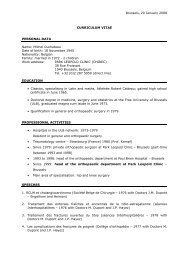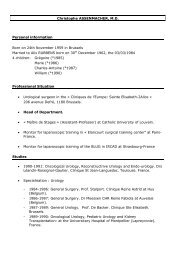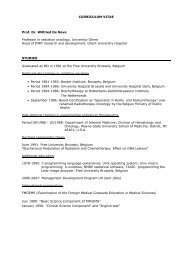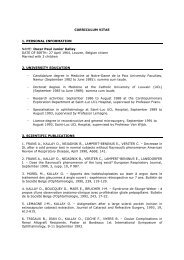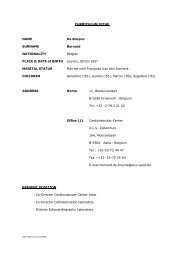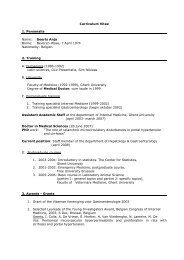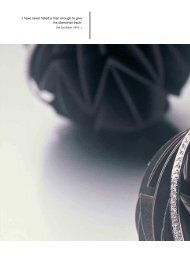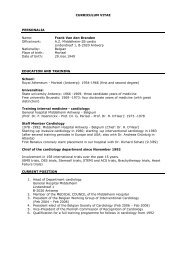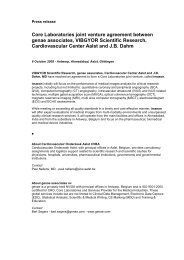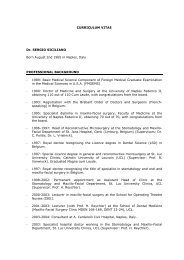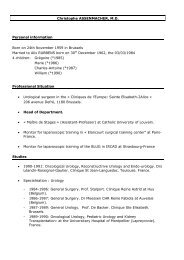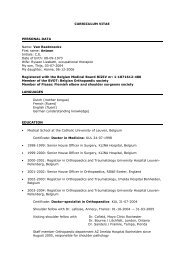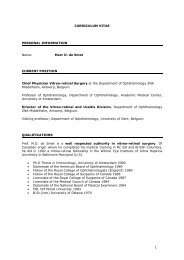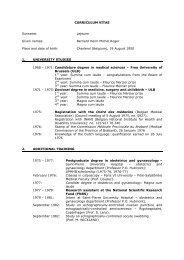Download PDF - HealthCare Belgium
Download PDF - HealthCare Belgium
Download PDF - HealthCare Belgium
Create successful ePaper yourself
Turn your PDF publications into a flip-book with our unique Google optimized e-Paper software.
to allow the ‘harvesting’ of ripe eggs. In most cases, a volunteer is<br />
found by the couple who need treatment by egg donation, but the<br />
CRG also tries to encourage healthy young women from outside<br />
the IVF circuit to volunteer as egg donors.<br />
Anonymous or not<br />
A general rule is that the donors are not told who the recipients<br />
will be, and vice-versa. To be sure the new legislation (2007)<br />
concerning assisted fertilization and everything related leaves<br />
open the option for known donation, but nevertheless implies in<br />
the formulation of the rules altogether a marked preference for<br />
anonymity. A specific situation in which this general rule may be<br />
waived is that of egg donation, i.e. if the recipient couple explicitly<br />
chooses their own egg donor or the donor offers to help a specific<br />
couple. This is known as ‘named donation’.<br />
However, there are also cases where several couples each provide<br />
a donor and the donors are exchanged among the group. This<br />
‘exchange donation’ system allows couples to find donors among<br />
their own families or friends, while still safeguarding the principle<br />
of anonymity. See ‘Named donation versus exchange donation’<br />
p. 103 for the reason why this may be important.<br />
Strict selection and genetic screening<br />
Obviously, not everyone is a suitable donor. All donors need to<br />
undergo rigorous medical screening before they are approved as<br />
donors. For example, a detailed family history is mapped out and<br />
analysed thoroughly to identify recurring characteristics. General<br />
factors such as life expectancy, physical health, mental stability,<br />
etc. are important here.<br />
The preliminary testing procedures include determination of the<br />
donor’s blood group and rhesus factor and the blood is also tested<br />
for the presence of infections such as hepatitis (jaundice) and HIV<br />
(the AIDS virus).<br />
A phenotype profile is compiled of every sperm donor. This involves<br />
the donor’s characteristics, i.e. hair and eye colour, skin colour,<br />
build, etc. When donor sperm is used, great care is always taken<br />
to ensure that the donor’s blood group and as many physical<br />
characteristics as possible match those of the recipient couple.<br />
79| Genetic map (karyotype) of a woman.<br />
80| Genetic map of a man.<br />
79<br />
80<br />
Unfortunately, this strict phenotype selection is not possible in<br />
cases of egg and embryo donation because the supply of donors is<br />
too limited and the treatment too complex. Furthermore, volunteer<br />
egg and embryo donors can only be recruited from among women<br />
up to the age of 35 years. Exceptions to this rule are only made in<br />
certain cases of named donation and with the recipient couple’s<br />
explicit permission.<br />
DONATION<br />
95




